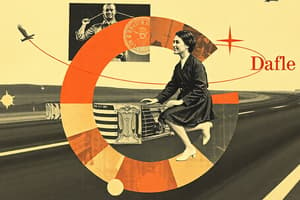Podcast
Questions and Answers
Which statement best describes a scalar quantity?
Which statement best describes a scalar quantity?
- It has magnitude and direction.
- It only has magnitude. (correct)
- It has speed only.
- It only measures force.
What is the formula for calculating acceleration?
What is the formula for calculating acceleration?
Acceleration = (Change in Velocity) / (Change in Time)
Velocity is the same as speed because both measure how fast an object is moving.
Velocity is the same as speed because both measure how fast an object is moving.
False (B)
In a distance-time graph, a steep line indicates __________ speed.
In a distance-time graph, a steep line indicates __________ speed.
Match the following terms to their definitions:
Match the following terms to their definitions:
What does the area under a velocity-time graph represent?
What does the area under a velocity-time graph represent?
Calculate the displacement of an object that has an initial velocity of 3 m/s, an acceleration of 2 m/s², and travels for 4 seconds.
Calculate the displacement of an object that has an initial velocity of 3 m/s, an acceleration of 2 m/s², and travels for 4 seconds.
When an object accelerates at a negative rate, it is called deceleration.
When an object accelerates at a negative rate, it is called deceleration.
Which of the following is considered a vector quantity?
Which of the following is considered a vector quantity?
Speed and velocity are the same because both measure distance traveled over time.
Speed and velocity are the same because both measure distance traveled over time.
What does a horizontal line on a velocity-time graph indicate?
What does a horizontal line on a velocity-time graph indicate?
The change in position of an object is known as __________.
The change in position of an object is known as __________.
Match the following quantities with their definitions:
Match the following quantities with their definitions:
How do you calculate average velocity?
How do you calculate average velocity?
A negative acceleration means that an object is always slowing down.
A negative acceleration means that an object is always slowing down.
The formula for calculating speed is __________.
The formula for calculating speed is __________.
Flashcards
Scalar Quantity
Scalar Quantity
A quantity that has only magnitude (size) but no direction.
Vector Quantity
Vector Quantity
A quantity that has both magnitude and direction.
Speed
Speed
The rate at which an object covers distance.
Velocity
Velocity
Signup and view all the flashcards
Acceleration
Acceleration
Signup and view all the flashcards
Equation for Speed
Equation for Speed
Signup and view all the flashcards
Equation for calculating displacement (constant acceleration)
Equation for calculating displacement (constant acceleration)
Signup and view all the flashcards
Equation for Calculating Final Velocity (constant acceleration)
Equation for Calculating Final Velocity (constant acceleration)
Signup and view all the flashcards
Distance vs. Displacement
Distance vs. Displacement
Signup and view all the flashcards
Velocity-Time Graph Slope
Velocity-Time Graph Slope
Signup and view all the flashcards
Velocity-Time Graph Area
Velocity-Time Graph Area
Signup and view all the flashcards
Constant Velocity on a Velocity-Time Graph
Constant Velocity on a Velocity-Time Graph
Signup and view all the flashcards
Constant Acceleration on a Velocity-Time Graph
Constant Acceleration on a Velocity-Time Graph
Signup and view all the flashcards
Changing Acceleration on a Velocity-Time Graph
Changing Acceleration on a Velocity-Time Graph
Signup and view all the flashcards
Calculating Average Velocity
Calculating Average Velocity
Signup and view all the flashcards
Calculating Instantaneous Velocity
Calculating Instantaneous Velocity
Signup and view all the flashcards
Study Notes
Scalars and Vectors
- Scalars have magnitude only (e.g., speed, distance, mass, time, energy).
- Vectors have both magnitude and direction (e.g., velocity, displacement, force, acceleration).
Speed vs. Velocity
- Speed is the rate at which an object covers distance. It's a scalar quantity.
- Velocity is the rate at which an object changes its position. It's a vector quantity, incorporating both speed and direction.
Distance vs. Displacement
- Distance is the total length of the path traveled. It's a scalar quantity.
- Displacement is the straight-line distance between the starting and ending points. It's a vector quantity.
Motion Graphs
-
Distance-Time graphs:
- The slope of a distance-time graph represents speed.
- A horizontal line indicates zero speed.
- A steeper line indicates higher speed.
- The area under a distance-time graph is not directly meaningful.
-
Velocity-Time graphs:
- The slope of a velocity-time graph represents acceleration.
- A horizontal line indicates constant velocity, meaning zero acceleration.
- A positive slope indicates increasing velocity (positive acceleration).
- A negative slope indicates decreasing velocity (negative acceleration or deceleration).
- The area under a velocity-time graph represents displacement.
Calculating Quantities
-
Calculating speed:
- Speed = Distance / Time
-
Calculating velocity:
- Velocity = Displacement / Time
-
Calculating Acceleration:
- Acceleration = (Change in Velocity) / (Change in Time)
- Acceleration = (Final Velocity - Initial Velocity) / Time
-
Calculating Displacement (for constant acceleration):
- Displacement = Initial Velocity * Time + 0.5 * Acceleration * Time²
-
Calculating Final Velocity (for constant acceleration):
- Final Velocity² = Initial Velocity² + 2 * Acceleration * Displacement
-
General Equations of motion:
-
v = u + at (velocity-time equation) * s = ut + 1/2 at^2 (displacement-time equation)
-
v^2 = u^2 + 2as (velocity-displacement equation)
-
where:
-
v = final velocity
-
u = initial velocity
-
a = acceleration
-
t = time
-
s = displacement
Examples and Problem Solving
-
Problem: A car accelerates from rest at a rate of 5 m/s². How far will it travel in 10 seconds?
- Use the equation s = ut + 1/2 at^2.
- u = 0 m/s, a = 5 m/s², t = 10 s.
- s = 0 * 10 + (0.5 * 5 * 10²) = 250 m
-
Problem: A train traveling at 20 m/s decelerates at 2 m/s². How long does it take to stop?
- Use equation v = u + at, where v=0 m/s, u = 20 m/s, a = -2 m/s².
- 0 = 20 + -2t
- t = 10 seconds.
Studying That Suits You
Use AI to generate personalized quizzes and flashcards to suit your learning preferences.




